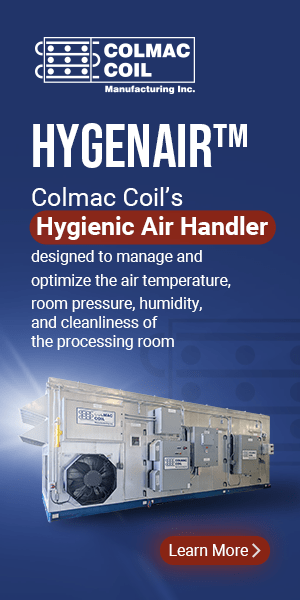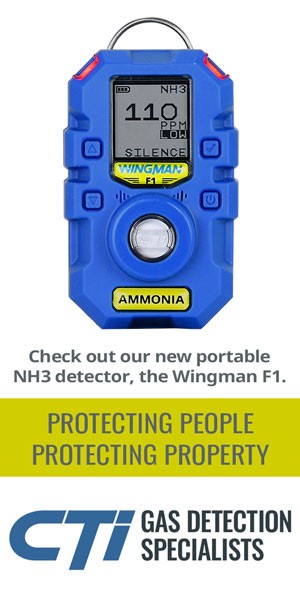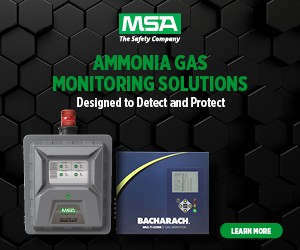Knowing Without Looking?
BY KEM RUSSELL

company for some time over the foreseeable future I didn’t respond to his statement, but started thinking if this is how many others feel.
This refrigeration system was computer controlled and had data and graphics to indicate operating conditions. In my conversation with the operator he said that he very rarely goes out to the refrigerated rooms, but scans the information on the HMI (Human Machine Interface) a few times a day. If parameters appear to be within acceptable ranges, he saw no reason to get out of the control room.
This facility has been operating for many years in an acceptable manner. However, I believe that staying in the control room or only remotely monitoring conditions in a system is not the best way to operate or inspect a system. Being able to do this does show how well most properly designed and constructed systems can function for years with very little human input, but this is not what is best.
Control systems for refrigeration systems have made amazing changes and improvements over many decades. The information now available to operators, and the presentation of that information, can greatly help a knowledgeable and trained refrigeration operator fine-tune a system for efficient and safe operation. Decisions can be made to keep the system running at its best, to not only make operational adjustments, but also to schedule maintenance when minor effort is required. Computer control systems for industrial refrigeration facilities started showing up in the early 1980’s. Many of these systems were PLC (Program Logic Controllers) based – systems from Allen Bradley, Sq. D, Siemens, etc. All have very reliable hardware, which had proven performance in industrial manufacturing fields. The challenge now was development of control logic for the industrial refrigeration system. This was a rocky road in many cases since knowledge of what control should happen in an industrial refrigeration system was not understood by programmers. Although refrigeration systems seem similar, they have unique aspects for proper operation, which must be appropriately considered in the control logic.
The early versions of control were ladder logic, which basically simulated the ladder-logic control drawings produced to wire the system and build the appropriate control panels. As control changed from relays, timers, steppers, etc. to programmed logic, the PLC slowly advanced to not only do the control, but also do it better and faster.
Also, in the early 80’s, computers started to be available and these began to be applied to refrigeration control systems. The programming in BASIC (some), C and C++ (most) was a long trial-and-error process. The graphics on the early systems were, you might say, primitive — but this would change. These computer-controlled systems opened up a world for more intuitive operator input as well as informative graphical display of system operational conditions. With the improvements of the computer systems there was more reliable hardware, faster and larger RAM and data storage, and overall faster processing speed, all of which led to greater strides forward for refrigeration system control, if it all worked properly.
Through the 80’s and into the 90’s I spent many, many days at refrigeration facilities, along with a programmer, in the development and fine tuning of refrigeration control systems. I would watch the data being presented by the computer, and also the actual operation of the refrigeration system. The programmers I worked with were amazing at development of the code to operate a system.
However, I can honestly say that I never, at any project, found the operation of the system to not require some changes/modifications/etc. The programmers wrote the code to do what they thought was appropriate, but they didn’t have sufficient understanding of just what should be happening out in the real world.
The programmers were the “software”, and I was the “hardware”. On projects I would go out through the refrigeration system watching and listening. Most times things don’t happen really fast in a refrigeration system, so this watching and listening took more than a casual glance. I would do the observation than go back and talk with the programmer as well as see what the control system was doing. Usually, this was not a onetime process but took checking and re-checking to get the actions of the control system within acceptable performance ranges in the field. This checking in the field did not end even after the computer control systems were performing well.
Here is just one example: At a large distribution center, with multiple operating temperatures, I visited the facility a few months after the facility had been commissioned. I spent more than an hour watching the operation of the computer control system and the graphic information, which included display capability of a large amount of historical data. In viewing the data of the freezer storage, something just seemed “off” to me. The large -10°F freezer and separate -20°F ice cream storage had both been holding temperatures within acceptable ranges, but the temperature split on many of the penthouse evaporators just didn’t appear to me to be in the right range.
I asked the refrigeration operator if he had looked at the coils in those penthouses. He hadn’t, for two reasons. One, the temperatures were okay. Two, it was a long walk from the control room through the facility, up the stairs to the roof and across the roof to the penthouses. Well, I said, since I am a visitor here why don’t you go with me and we’ll take a look. About 10 minutes later we stepped inside one of the penthouses.
There were four large evaporators in each of two freezer penthouses. The air-return side of the coils showed a pretty thick frost and ice buildup along the edges between fan sections and all long the pans. I suggested that he turn off one of the units so we could also visually check the air-discharge side of the units. These units had ductwork that directed the air from the coil, down 90 degrees through the penthouse grating to horizontal ductwork within the room. Each fan section had a fairly easily accessible panel opening to access the fan motors and to see the discharge side of the coil.
Upon opening the access panel and looking inside, I turned to the operator and said I think we have a problem. There was a large buildup of what I call “hoar” frost over a large portion of the discharge-air side of the coil, which extended several inches toward the fan. The operator looked in there and said, “Oh man!” (Well, he might have used other words). We checked several other coils and found a similar condition, including the units in the ice cream penthouse.
The solution was: One, do some immediate unit cleaning. Two, to make adjustments to the defrost sequence and timing, which eventually corrected the hoar-frosting problem. Fortunately, this problem was caught before it became a serious mess. This problem could have been discovered much earlier, but the operator had put all of his understanding of what was happening in the system to what he was observing at the HMI.
Lesson learned: Do not rely only on the information you see in your control system. This can be a very useful tool, but should be combined with regular, actual system observations by a refrigeration operator who is knowledgeable and trained in the operation of his system. Putting all your eggs in one basket will eventually end up with some cracked eggs.











